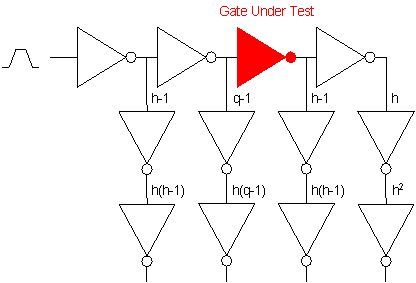Short-Circuit Energy Component
Short-Circuit
current on the direct path from power supply Vdd to the ground exists while
p-MOS and n-MOS transistors are both conducting. This is the case during the
output switching time, both charging and discharging.
Consequently, energy dissipation due to the short-circuit energy component
is calculated by multiplying the energy of one transition with the output
switching activity factor.
Energy associated with short-circuit component can be measured by
integrating the current of the n-mos transistor during the low-to-high
output transition, and vice versa by measuring the p-mos current while the
n-mos is discharging the output to low value. The current due to the
capacitive coupling is isolated and taken into account as well.
The first solution of the short-circuit
energy component dissipated in the inverted was given by
[Veendrick 84]. More accurate model was
presented by
[Hedenstierna and Jeppson 87]. Both models were
based on the square-low MOS equations. [Sakurai and
Newton 90] introduced alpha-power law MOS model and derived
expression for short-circuit energy dissipation of the inverter under the
same assumptions as in [Veendrick 84].
Design considerations for minimizing
the short-circuit energy component are given in the following examples.
Verba docent, exampla
trahunt
In order to illustrate the effect of input/output
transition times, i.e. input/output slopes, and output load on the short-circuit energy
dissipation of the inverter gate under test, the setup shown in
Figure 1 is used.

Figure 1. Circuit setup
By varying output and input fanouts, h and q, respectively, the measured
short-circuit energy component is illustrated in Figure 2.
The maximum of the short-circuit energy dissipation occurs when the input
fanout is big (q), whereas the fanout at the output is small (h).
Figure 2. Short-Circuit Energy dependence
on input/output fanouts (q and h, respectively)
With a certain amount of latitude remaining, the rule
for minimization of associated short-circuit energy component would be
right-hand side of the polyhedron. The concluding remarks of the analysis
given in [Veendrick 84] state that if the output and input signal have equal
transition times, the short-circuit will be only a fraction (<20%) of the
total dissipation and to minimize the short-circuit energy dissipation an
inverter should be designed in a way that the input transition times are
less than or about equal to the output transition times.
The proposed optimization corresponds to the setup case shown in Figure 1 and
having the equal slopes at the input and output when q value is
set to be equal to h. The results are summarized in the following graphs,
Figures 3, 4.
Figure 3. Short-Circuit Energy Dissipation for equal input/output fanouts (h=q)
Figure 4. Percentage of Esc in total energy dissipation, Etot, versus h (h=q).
References:
[Al-Khalili et. al. 90] A. J. Al-Khalili, Y.
Zhu, D. Al-Khalili, "A
Module Generator for Optimized CMOS Buffers", IEEE Transactions on
Computer-Aided Design and Integrated Circuits and Systems, Vol. 9, No. 10,
October 1990.
[Hedenstierna and Jeppson 87] N. Hedenstierna,
K. O. Jeppson, "CMOS
Circuit Speed and Buffer Optimization", IEEE Transactions on
Computer-Aided Design, CAD-6(2), pp. 270-281, 1987.
[Hedenstierna and Jeppson 93] N. Hedenstierna,
K. O. Jeppson, "Comments
on 'A Module Generator for Optimized CMOS Buffers'", IEEE
Transactions on Computer-Aided Design of Integrated CIrcuits and Systems,
Vol. 12, January 1993.
[Kang 1986]
S. M. Kang, "Accurate
Simulation of Power Dissipation in VLSI Circuits", IEEE Journal of
Solid-State Circuits, Vol. 21, No. 5, pp. 889-891, October 1986.
[Nose and Sakurai 00] K. Nose, T. Sakurai, "Analysis
and Future Trend of Short-Circuit Power", IEEE Transactions on
Computer-Aided Design of Integrated Circuits and Systems, Vol. 19, No. 9,
September 2000.
[Sakurai and Newton 90] T. Sakurai, A. R.
Newton, "Alpha-Power
Law MOSFET Model and its Applications to CMOS Inverter Delay and Other
Formulas", IEEE Journal of Solid-State Circuits, 25(2), pp. 584-594.
[Turgis et. al. 95] S. Turgis, N. Azemard, D.
Auvergne, "Explicit
Evaluation of Short Circiut Power Dissipation for CMOS Logic Structures",
ISLPED 1995.
[Veendrick 84]
H. J. M. Veendrick, "Short-Circuit
Dissipation of Static CMOS Circuitry and its Impact on the Design of Buffer
Circuits", IEEE Journal of Solid-State Circuits, Vol. SC-19, pp.
468-473, August 1984.
[Yacoub and Ku 89] G. Y. Yacoub, W. H. Ku, "An
Enchanced Technique for Simulating Short-Circuit Power Dissipation",
IEEE Journal of Solid-State Circuits, June 1989.